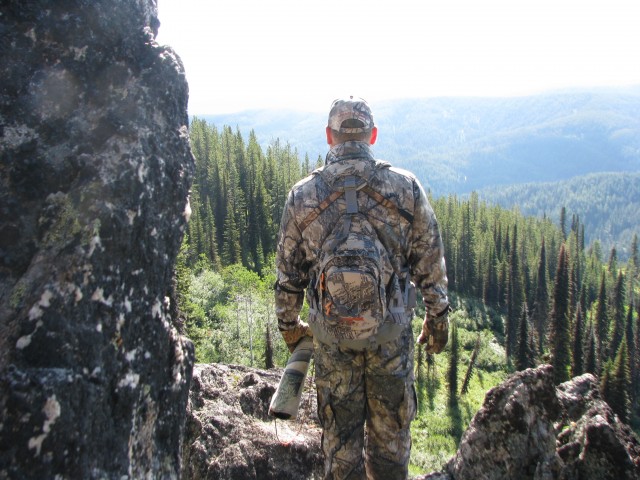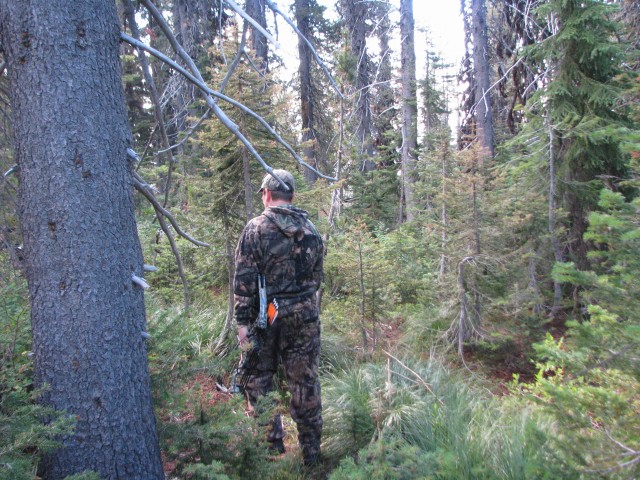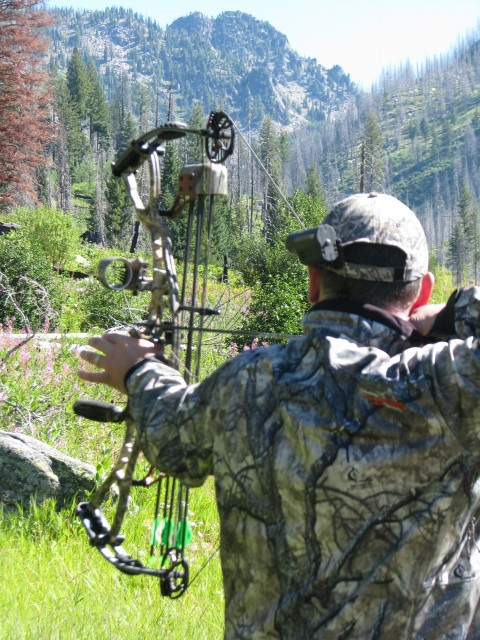Bugle, or slip in silent?
For most of us, being an effective elk killer is no “overnight success”. Years of patience, hard work, and learning from trial and error molds the hunter we are today. The old adage states “there’s more than one way to skin a cat”, and this can’t be more true in hunting big bulls. As we evolve, we base our hunting style on our own experiences with success and failure. We grow, and soon we have a method that has proven successful over time, and we tend to go there time after time hoping for the same yield – a dead elk.
Stalking Bugling Bulls
Playing a game of cat and mouse with a bugling bull elk will test the patience and physical conditioning of any hunter. The build-up to the climax of the hunt when you are finally able to take your shot is quite an accomplishment. Terrain,vegetation, wind, weather, and overall disposition of the bull will dictate your every move. Move in too fast and you may be picked off by a cow. If you play it safe and lag too far behind, you risk being out distanced in the mountainous terrain. You must plan your every step, holding your cards tight until just the right moment. This can be very tricky as the elk suck you into their game.
The type of vegetation in your hunting area must be conducive to stalking. Too much brush and elk will hear you coming, often busting out just before you can see them. I archery hunted an area in NE Oregon solo one year where there was no under brush at all, just large, spaced-out, Poderosa pine trees. The groups of 100+ elk could see my approach from 100-200 yards out, and were unresponsive to my calls as there were multiple bulls bugling constantly. All these details slowed the game down considerably. I would creep up as close as possible once they all bedded, and then I would belly crawl the final distance . The bull would always bed in the middle of the cows and it was nearly impossible to get a clear broadside shot. After a week of blown stalks on trophy bulls, I took out my frustrations on a hapless cow the last day of season.
If you prefer stalking in silent rather than calling, pick areas which have sufficient ground cover that wont hinder your movement. Finding the perfect balance of broken terrain, and ground cover will make your hunt more successful.
Calling in Bulls
Bugling in bulls is an adrenaline rush, and second to no other hunt. For those of us who are a little too impatient, calling elk is much more our speed. A bull bugling in the distance at your every call is exhilarating and more often than not, puts the game into your court. By calling in the bull, your setting up the playing field rather than silently stalking him where ever the bull may lead you in his daily travels.
Calling bulls in thick or moderate cover puts the odds in your favor. Sometimes when calling a distant elk, other bulls may join the ruckus and show up sooner than the first bull, giving you options and increasing your up close contact. By being silent, you may have passed right by many bulls that are closer to the truck while pursuing the one you knew about off in the distance. By doing this, you may in fact have multiple interactions with different bulls before noon, where as by silent stocking puts all your eggs in one basket and many unnecessary miles on your feet.
Being impatient, I like a more aggressive approach when bugling bulls. Yes, I will sometimes let the the argument between the bull and I escalate slowly like a teenagers first kiss. But once he locks up at 50-75 yards for a few minutes when he decides the fight’s not going to happen without the challenger’s next move, that’s when the gloves come off. When he turns to leave. I charge towards him and scream a bugle, gaining ground until I find a suitable shooting lane closer to the bull. Then, when the bull turns and comes back to face his challenger, he’s only to meet a razor sharp broad-head to seal his fate.
Best of Both Worlds
I’d be lying if I said every calling set up worked like magic, or every long stalk ended in a happy blood trail. Being versatile with your simple calling set up is key to success. Whether it be semi-open country or brush choked timber, we’ve switched gears and had excellent results on herd bulls who will bugle their brains out, but just wont budge. This is where team work comes together – having the caller stay back and keep the bull talking while the shooter creeps toward the distracted bull. The shooter then closes the last distance for a shot as the bull rakes his horns or runs cows back and forth. If the shooter still can’t get the last crucial steps completed, that’s when the caller moves up closing the gap, hopefully pulling the bull the last few yards.
Ultimately, at the end of the day, we’re all looking for the same outcome; a bull on our back, and a big beautiful rack. By calling elk, you’re putting more bulls in front of you per hunt and that will stack the odds in your favor.
I won’t try to say who’s right or wrong on their tactics, but I will say, don’t get bogged down with complex calling rituals or the same old routine of skulking silently for miles, keep it simple, mix it up, and enjoy more success in the elk woods!




